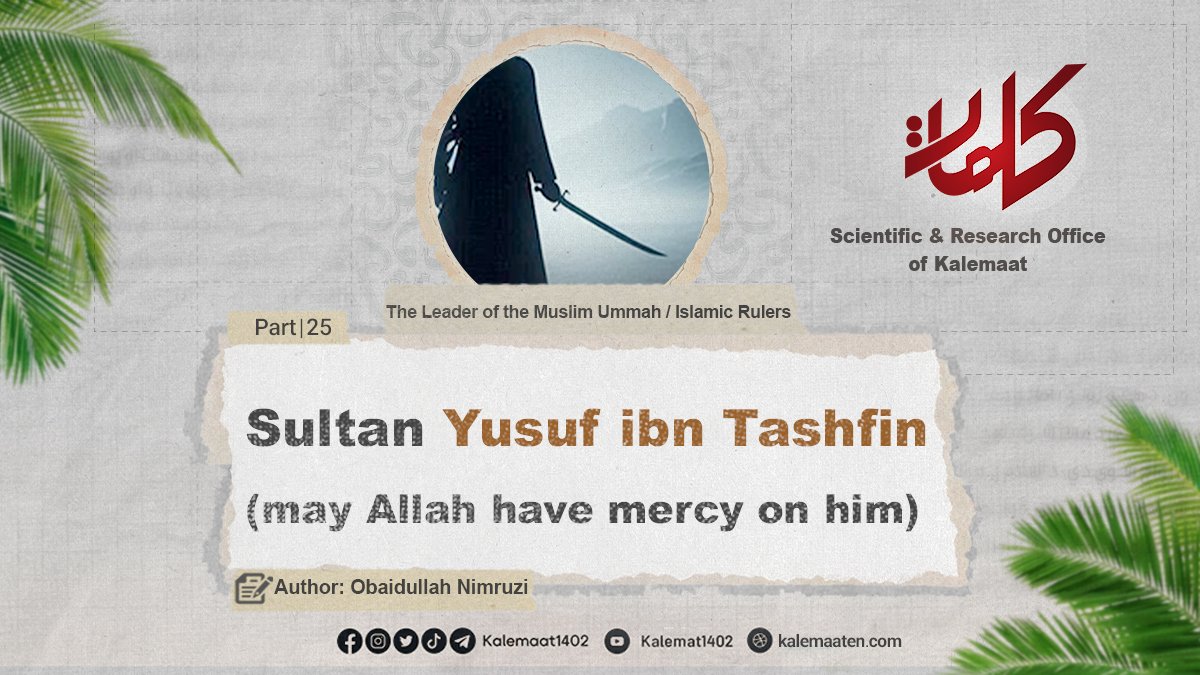Author: Obaidullah Nimruzi
The Guardian of Al-Andalus (Spain); Sultan Yusuf ibn Tashfin [MABH] (Part 25)
The Peak of Yusuf ibn Tashfin’s Military Genius
Here we must highlight the military genius of Yusuf—a brilliance through which he made full use of all available resources and employed them in the path of Allah’s pleasure and in service to the believers. He gave special importance to the order and organization of the army. The backbone of the army consisted of skilled cavalry units equipped with the best weapons, whose numbers reached one hundred thousand during his time. Each unit had its own flag with specific colors and patterns, knew its appointed leader, and the army would march into battle to the sound of drums. The formations were also arranged according to tribal affiliations. [1]
The Next Step: Marching Toward Fes, the Heart of Resistance
After extensive preparations, Yusuf ibn Tashfin set out from Marrakesh toward the city of Fes, which was the stronghold of the Zanata tribal resistance. There, he encountered tribes such as Zuwagha, Lamaya, Sadinah, Sadrata, Maghila, Bahlula, Madyuna, and many others. A fierce battle ensued. [2]
The Conquest of Sadinah: Center of Tribal Resistance Against the Al-Murabitin (Almoravid)
These tribes had chosen the city of Sadinah as their operational headquarters against the Murabitin. With perseverance and dedicated struggle, the Murabitin succeeded in defeating them and penetrating the fortress in which they had barricaded themselves. Then they destroyed the defensive walls the tribes had built to protect Sadinah. [3]
The Conquest of Fes: Capturing the Fortress and Defeating Local Rulers
After the defeat of these tribes, the path to Fes was open. Yusuf ibn Tashfin stayed in Fes for a time and then killed the city’s governor, Bakkar ibn Ibrahim. He then marched toward the city of Safru.[4] From the moment he entered Safru, he conquered it by force and defeated the resistance of the local rulers, including the descendants of Masoud al-Maghrawi, who held Sijilmasa. Afterward, Yusuf and his army returned to Fes and laid siege to it until it was conquered. This was the first conquest of Fes, which took place in the year 455 AH. [5]
Establishing Murabitin Authority and Reforming Religious Affairs in Fes
After the conquest of Fes, Yusuf ibn Tashfin appointed a governor from the Murabitin to reform the city’s affairs and establish religion within it. [6] Mansur ibn Hammad al-Maghrawi, the former ruler of Fes, fled the city. Once security was restored, Yusuf led his army to continue conquering other regions.
The Emir of Meknasa Submits to the Murabitan
Around this time, Mahdi ibn Yusuf al-Kaznayi, the emir of Meknasa, pledged allegiance to Yusuf ibn Tashfin and accepted the authority of the Murabitin. Yusuf confirmed his position. [7] This recognition reflected the acceptance of reforms and a movement toward unity.
Continued Resistance from Maghrawi and Zanata Tribes and an Attack on Fes
Some tribes, such as the Banu Mansur al-Maghrawi and the Zanata, continued to resist. Upon hearing that Mahdi ibn Yusuf al-Kaznayi had gone to Yusuf ibn Tashfin, they attacked Fes and killed the appointed governor. In the fierce battle that followed, the emir of Meknasa was killed, and his forces were scattered. [8]
Alliance of Anti-Murabitin Tribes and Their Connection with the Barghawata
Tamim ibn Mansur al-Maghrawi was the commander of the forces in Fes. He sent the severed head of the emir of Meknasa to Sakut al-Barghawati, the ruler of Ceuta. This act indicated an alliance among tribes opposed to the Murabitin, who had begun cooperating to resist them. The Murabitin sought to reform these tribes and the regions they controlled, which were being run on the basis of illegitimate interests and oppression. [9]
The Murabitun’s Jihad Against the Barghawata: Confronting Corruption and Innovation
The Murabitin viewed their struggle against the Barghawata—who were known for moral corruption and deviant beliefs—as a legitimate jihad and an act of drawing near to Allah. This jihad was aimed at reforming and purifying the region and confronting religious innovations. [10]
Loyalty of the People of Meknasa and the Siege of Mahdi’s Fortress
The people of Meknasa, who had embraced the Murabitun’s cause, wrote a letter to Yusuf ibn Tashfin pledging their loyalty. Yusuf sent an army to lay siege to Mahdi’s fortress. This siege lasted about nine years until the fortress was finally captured in the year 456 AH.[11]
Continues…
Previous Part
References:
[1] Yusuf Ashbach, Tarikh al-Andalus fi ‘Ahd al-Murabitin wa al-Muwahhidin, p. 479.
[2] Ibn Abi Zar‘, Rawd al-Qirtas, p. 89.
[3] al-Salawi, al-Istiqsa, vol. 2, p. 27.
[4] Ibn Abi Zar‘, Rawd al-Qirtas, p. 90.
[5] Ibid.
[6] Ibn al-Khatib, A‘mal al-A‘lam, vol. 3, p. 235.
[7] Ibn Abi Zar‘, Rawd al-Qirtas, p. 90.
[8] Ibid., p. 90.
[9] Ibid., p. 90.
[10] Ibn al-Khatib, al-Nuzhah, vol. 2, p. 148.
[11] Ibn Abi Zar‘, Rawd al-Qirtas, p. 91.



